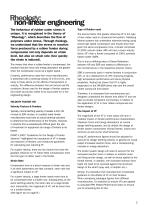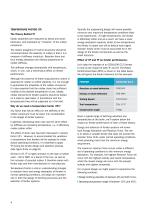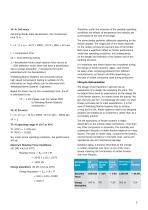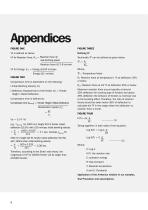 Website:
Trelleborg Marine and Infrastructure
Website:
Trelleborg Marine and Infrastructure
Grupo: Trelleborg
Excertos do catálogo

Applying the right Correction Factors
Abrir o catálogo na página 1
Introduction In recent years, rubber manufacturing industries have experienced an evolution in both the emergence of contract mixers, and new manufacturers in low cost countries becoming mainstream manufacturing hubs. Additionally, a wider range of ingredients are available for rubber compounding. These changes, especially those related to rubber compound, are a significant departure from tradition. It is critically important that the industry understands the impact these changes in ingredients have, not just on the rubber compound, but also the downstream effect on fender performance and...
Abrir o catálogo na página 2
Rheology: non-linear engineering The behaviour of rubber under stress is unique. It is recognised in the theory of “Rheology”, which describes the flow of polymers under stress. Through rheology, we understand that the stress or reaction force produced by a rubber fender during compression not only depends on strain level, but also on strain rate (how quickly the strain is induced). This means that when a rubber fender is compressed, the resultant reaction force and energy absorption are greater when the compression occurs at a higher speed. Currently, performance data from most...
Abrir o catálogo na página 3
TEMPERATURE FACTOR (TF) The Theory Behind TF Elastic properties are measured by stress and strain behaviour, and expressed by “modulus” of the rubber compound. The reason designers of marine structures should be concerned about the elasticity of rubber is that it is a measure of stiffness (modulus). Reaction force and thus energy absorption are directly proportional to rubber stiffness. This stiffness changes dramatically with temperature, which, in turn, has a tremendous effect on fender performance. Although the presence of these long polymeric chains is essential for rubber to exhibit...
Abrir o catálogo na página 4
VF: At 160 mm/s Assuming steady state deceleration, the compression time (t) is: t = d / (ƒ x vd)= (0.72 x 1000) / (0.74 x 160) = 6.1 sec t = compression time Vd = initial berthing velocity ƒ= deceleration factor (peak reaction force accurs at ~ 30% deflection where there has been a deceleration due to energy absorption. ƒ represents the factor associated with the deceleration.) (Trelleborg Marine Systems has conducted actual high speed compression testing to validate its VFs. Information on these effects can be discussed with Trelleborg Marine Systems’ Engineers). Based the strain rate for...
Abrir o catálogo na página 5
The mechanisms that produce oxidative aging depend not only on the degradation agent (oxygen, Ozone, UV radiation etc) present in the environment but also the type of rubber used (virgin or recycled), and the types of additives used in the compound formulation. Trelleborg Marine Systems has developed analytical techniques to identify the rubber composition of fenders, making it possible to accurately determine the presence of ingredients that are critical to the life of the fender. These include percentages of recycled or virgin rubber as well as non-reinforcing fillers, amongst others....
Abrir o catálogo na página 6
Conclusion Changes in the rubber fender market in recent years include changes to compound formulations and new ingredients, many of which have occurred without the necessary understanding of the impact on engineering design or life expectancy. Despite PIANC recommending the application of TF and VF, these are really only the starting point in the design and selection of rubber fenders. Many suppliers (trading houses) and manufacturers either do not make the necessary investment in research and development to underpin their claims, or apply far too low factors to their products. Many...
Abrir o catálogo na página 7
FIGURE THREE VF for Reaction Force, Rvcf = Reaction force @ real berthing speed Technically TF can be defined as given below: Reaction force @ 2-8 cm/min VF for Energy: Evcf = Energy @150 mm/sec Compression time is dependent on the following: Rt: Reaction force at temperature t ºC at deflection 35% or below ❙ Initial Berthing Velocity (Vi) R23: Reaction force at 23 ºC at deflection 35% or below ❙ eflection Displacement of the fender (d) = Fender D Height x Rated Deflection Compression time is defined as: ( Compression time (tBerthing) = Fender Height X Rated Deflection) Deceleration speed...
Abrir o catálogo na página 8
❙ We assumed that oxidative aging, a chemical process, was responsible for the elongation at break reducing from its unaged (original) value at higher temperature ❙ Unaged (original) elongation at break was measured for both the samples at room temperature ❙ The rate of oxidative aging reaction of both the samples was obtained from the change in the value of elongation at break from the original, in a 2 days interval for 32 days at 80/90/100 ºC. Elongation at break at different temperatures was plotted against log hours for each exposure time for both the samples ❙ Through our experience,...
Abrir o catálogo na página 9
Trelleborg is a world leader in engineered polymer solutions that seal, damp and protect critical applications in demanding environments. Its innovative engineered solutions accelerate performance for customers in a sustainable way. The Trelleborg Group has annual sales of about SEK 21 billion (EUR 2.3 billion, USD 3.2 billion) in over 40 countries. The Group comprises five business areas: Trelleborg Coated Systems, Trelleborg Industrial Solutions, Trelleborg Offshore & Construction, Trelleborg Sealing Solutions and Trelleborg Wheel Systems. In addition, Trelleborg owns 50 percent of...
Abrir o catálogo na página 10Todos os catálogos e folhetos Trelleborg Marine and Infrastructure
-
SafePilot brochure
20 Páginas
-
TSX5 Shaft Power Meter brochure
9 Páginas
-
Docking & Mooring
88 Páginas
-
Pneumatic Fender infographic
1 Páginas
-
Pneumatic Fenders brochure
28 Páginas
-
Fender Application Design Manual
88 Páginas
-
Multipurpose and Tug Fenders
44 Páginas
-
Rolling Fenders and Safety
18 Páginas
-
AutoMoor Brochure
24 Páginas
-
Fender Systems
86 Páginas
-
DynaMoor
20 Páginas
-
Bollards
28 Páginas
-
Solid SmartFender Factsheet
2 Páginas
-
Ship-Shore Links Factsheet
4 Páginas
-
Navigating & Piloting Factsheet
2 Páginas
-
SmartDAS Factsheet
2 Páginas
-
SmartPort by Trelleborg Factsheet
2 Páginas
-
TRELLEBORG DYNAMOOR
4 Páginas
-
SmartDock ® Display Board
4 Páginas
-
Surface Buoyancy
24 Páginas
-
SmartMoor Series II
7 Páginas
-
Performance Monitoring
3 Páginas
-
Universal Safety Link
3 Páginas
-
TRELLEBORG’S Low Maintenance Hook
2 Páginas
-
TRELLEBORG’S Tugger Winch
2 Páginas
-
LNG Infographic
8 Páginas
-
SafePilot CAT ROT-I-XT User Guide
17 Páginas
-
SafePilot User Guide
30 Páginas
-
SafePilot Shore Viewer User Guide
13 Páginas
-
SafePilot Piloting with One Touch
16 Páginas
-
Safepilot SmartPort System
16 Páginas
-
ReadyMoor Quick Release Hooks
6 Páginas
-
Docking, Mooring & Transfer for LNG
20 Páginas
-
Combined ESDS & SSL
3 Páginas
-
Ship Shore Link System
3 Páginas
-
Emergency Shutdown Link
3 Páginas
-
Floating Fenders
48 Páginas
-
Prelude LNG
1 Páginas
-
AutoMoor Datasheet
4 Páginas
-
SmartMoor Quick Release Hooks
8 Páginas
-
SafePilot CAT XT System
2 Páginas
-
SafePilot CAT II CAT III System
2 Páginas
-
SafePilot CAT I Beidou System
2 Páginas
-
Case Study - Singapore LNG Terminal
1 Páginas
-
Case Study - LNG terminal, China
1 Páginas
-
Mini Guide - Foam Fenders
5 Páginas
-
Buoy Range Table
2 Páginas
-
Docking & Mooring Aftersales Service
2 Páginas
-
Hawser Hooks
6 Páginas
-
Guide - Fenders
8 Páginas
-
Barometer Report 3
16 Páginas
-
Barometer Report 2
7 Páginas
-
Whitepaper - Avoid the Disconnect
12 Páginas
-
lload monitoring software
2 Páginas
-
lload monitoring systeme
5 Páginas
-
Remote Release System
6 Páginas
-
Capstans
4 Páginas
-
Accessories
10 Páginas
Catálogos arquivados
-
Docking and mooring
2 Páginas






















































































